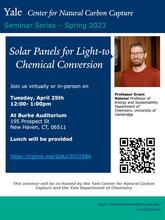Abstract: Solar panels are well known to produce electricity, but they are also in early-stage development for the production of sustainable fuels and chemicals. These panels mimic plant leaves in shape and function as demonstrated for overall solar water splitting to produce green H2 by the laboratories of Nocera and Domen.1,2
This presentation will give an overview of our recent progress to construct prototype solar panel devices for the conversion of carbon dioxide and solid waste streams into fuels and higher-value chemicals through molecular surface-engineering of solar panels with suitable catalysts. Specifically, a standalone ‘photoelectrochemical leaf’ based on an integrated lead halide perovskite-BiVO4 tandem light absorber architecture has been built for the solar CO2 reduction to produce syngas.3 Syngas is an energy-rich gas mixture containing CO and H2 and currently produced from fossil fuels. The renewable production of syngas may allow for the synthesis of renewable liquid oxygenates and hydrocarbon fuels. Recent advances in the manufacturing have enabled the reduction of material requirements to fabricate such devices and make the leaves sufficiently light weight to even float on water, thereby enabling application on open water sources.4 The tandem design also allows for the integration of biocatalysts and the selective and bias-free conversion of CO2-to-formate has been demonstrated using enzymes.5 The versatility of the integrated leaf architecture has been demonstrated by replacing the perovskite light absorber by BiOI for solar water and CO2 splitting to demonstrate week-long stability.6
An alternative solar carbon capture and utilization technology is based on co-deposited semiconductor powders on a conducting substrate.2 Modification of these immobilized powders with a molecular catalyst provides us with a photocatalyst sheet that can cleanly produce formic acid from aqueous CO2.7 CO2-fixing bacteria grown on such a ‘photocatalyst sheet’ enable the production of multicarbon products through clean CO2-to-acetate conversion.8 The deposition of a single semiconductor material on glass gives panels for the sunlight-powered conversion plastic and biomass waste into H2 and organic products, thereby allowing for simultaneous waste remediation and fuel production.9 The concept and prospect behind these integrated systems for solar energy conversion,10 related approaches,11 and their relevance to secure and harness sustainable energy supplies in a fossil-fuel free economy will be discussed.
